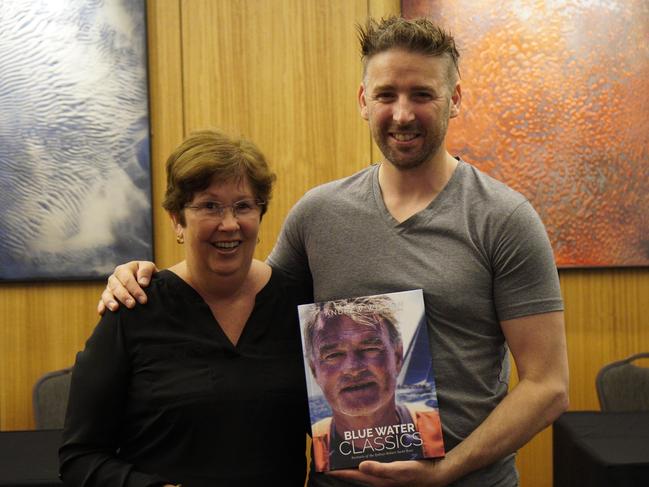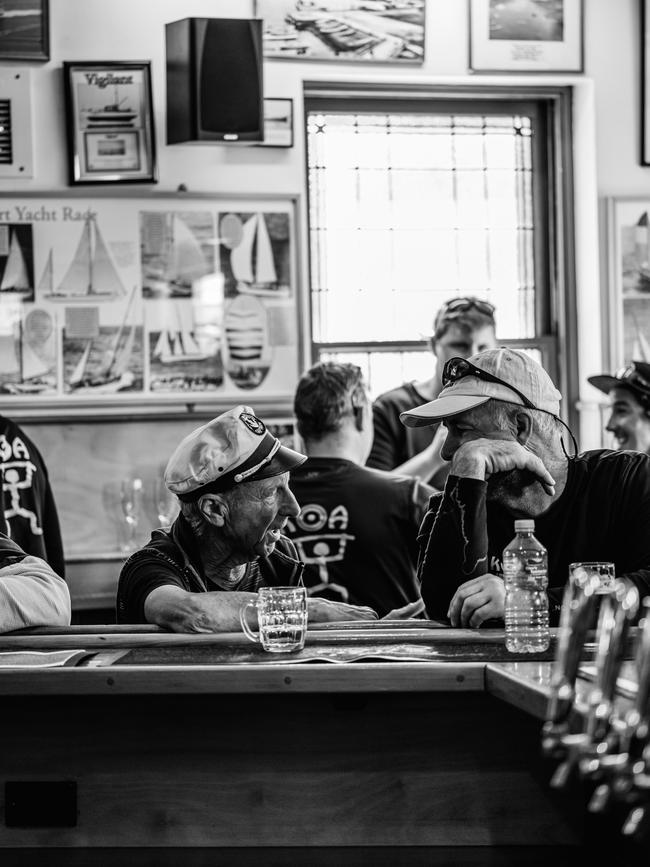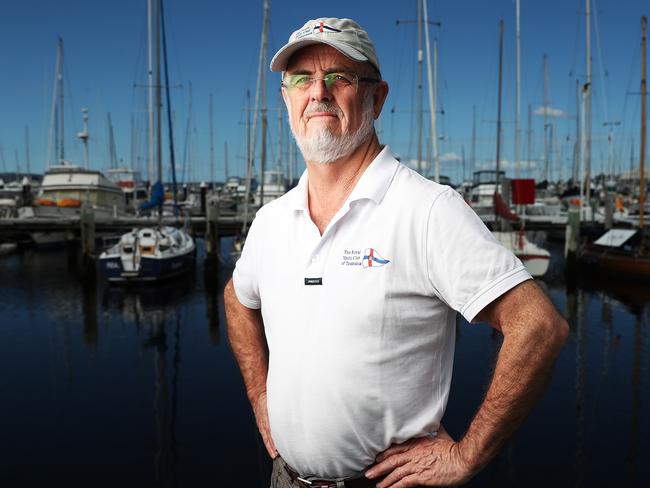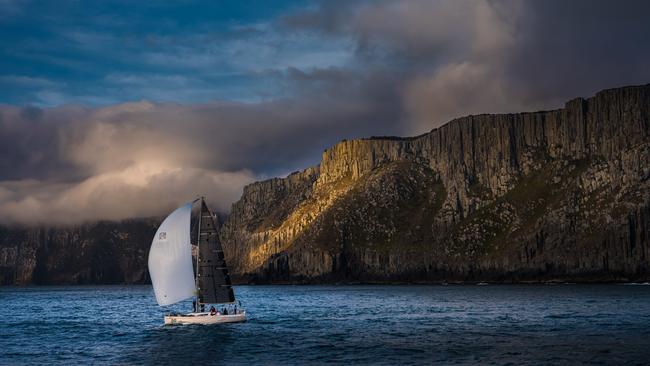Just as COVID-19 may have helped refocus the iconic Sydney-Hobart yacht race, it also put the wind in the sails of photographer Andrew Wilson, enabling him to get his book over the finishing line.
NOT only did the COVID-19 pandemic fail to sink the famous Rolex Sydney to Hobart Yacht Race, but the event just might have emerged stronger.
With 90 boats registered, numbers are at the high end of the spectrum, with the average number of entries usually between 80-90. And with only two super maxis taking part, it could well be the smaller vessels’ year to shine.
And for Hobart photographer Andrew Wilson, the lengthy lockdown period gave him the at-home time he needed to finish his book about the race.

A work in progress since 2016, Blue Water Classics features portraits of some of the Sydney-Hobart’s more famous faces, its veterans, its champions, its stunning scenery, and in-depth interviews with its subjects.
“I wandered down to the docks in Hobart at the end of the 2017 race just to see who I could meet and to gauge whether there was much interest.
“There weren’t many boats in but Paul Clitheroe had just arrived on his boat, Balance, so I walked up to him and introduced myself, asked if I could take his photo and call him later for an interview.
“He said yes, and the photo was wonderful. He’s just come in to the dock, he looks soggy but exhilarated, knackered but content that he finished.”
Wilson is no stranger to yachting, himself. His father, veteran Derwent sailor Bob Wilson, was the inspiration for his first photo book in 2013, Old Sea Dogs of Tasmania, and once won the Tilman Trophy in the British Three Peaks Race, as well as competing in one Sydney-Hobart.
After photographing his dad and numerous other local yachties and writing their stories to accompany the portraits, Wilson exhibited some of those photographs at the 2013 Wooden Boat Festival, which was when he realised the impact those backstories had on people looking at the photographs.

But when he started approaching Sydney-Hobart sailors for his latest book, Wilson says he still found himself slightly out of his depth.
“My lack of understanding was apparent when I was on the docks and a boat came in and there was a journalist there holding out a microphone and asking, ‘How does it feel to be first sailor to do more than 50 races?’
“I didn’t even know who this guy was! It was Tony Cable, I went up to him and took a photo of him and later learnt his story. I find it remarkable that some people just do this race over and over every year, they love it, and they have so many stories. You could do a full book on any one of these guys.”
Wilson was going to art school in the 1990s when he landed a job as an assistant producer for TV commercials with an advertising agency.
After 15 years of that he made the switch to becoming a full-time photographer and has never looked back. He now runs his own business, Everything Everything, specialising in photography, film and graphic design.
His two volumes of Old Sea Dogs of Tasmania captured a great deal of attention for their emotive and captivating portraits of local sailors and boaties, sharing their fascinating stories with audiences who, otherwise, might never have heard them.

With Blue Water Classics, Wilson enlisted the help of Di Pearson, a Sydney-based journalist and race media director for the Sydney-Hobart, to help with the interviews and writing, as well as for her broad knowledge of the race and its identities.
“I called the Cruising Yacht Club of Australia (CYCA) to ask about getting a media pass and that’s how I met Di,” Wilson says.
“I’m just a photographer who made himself become an author! I failed English at school, I was kicked out of the creative writing course in college and told to look for a different course to study.”
Working with Pearson, Wilson settled on a Q&A style for many of the stories in the book, preserving the conversational tone of the interviews themselves.
“As a writer, I want to write as if I’m telling the story to a friend,” he says. “So it is deliberately conversational.
“Also, if I extrapolated the stories and retold them in my own words, like in Old Seadogs, it would have taken up a lot more pages, and I wouldn’t have been able to fit as many people in.”

The book is structured to lead the reader through the chronological order of the race, from its start in Sydney Harbour on Boxing Day, out the Heads, down the east coast of Australia, across the “paddock” of Bass Strait, around the dramatic cliffs of south eastern Tasmania and up the River Derwent to a warm Hobart welcome.
There are even chapters dedicated to the media, the briefings and the post-race celebrations.
But the 520-page book, with its 40 photographs, was a gargantuan task to put together and, after several years of working on it, Wilson was feeling the weight of the endeavour.

In the end, the COVID-19 lockdown was probably his saving grace.
“I originally wanted to release it last year for the 75th race but I wasn’t finished with it, I didn’t have all the content I wanted, so I delayed it by a year.
“At the beginning of this year I said to my wife, all I need is a couple of months to just sit down in a room and write, with no distractions, nowhere else to go.
“Well, I got it! I spent a solid four months writing and proofing and got the thing done.”
That pandemic period was slightly less of a godsend for those organising the race, though. The uncertainty about interstate and international travel cast heavy doubts over whether the event could be held at all, to say nothing of the social distancing that might be required, and exactly what the world would even look like by the end of the year.

Royal Yacht Club of Tasmania Commodore Richard Bevan says he was feeling concerned right up until the official announcement was finally made in early November that the race would go ahead.
“If you’d asked me in early October what the probability was of the race going ahead, I would have said pretty low,” he says.
“At that stage the borders were still closed between NSW and Tasmania, which meant that no boat leaving Sydney Harbour could come in to Hobart, so that pretty much shut us down.
“So it was great news that the borders could reopen and the race could go ahead. From start to finish, it will operate pretty much as normal.
“There will just be more controls around managing crowds around the waterfront, checking crew members as they arrive, having procedures in place to deal with any symptoms that are reported and so forth.”
Describing 2020 as a “screaming disaster” – an observation few would disagree with – Bevan said organisers were seriously discussing what the lowest cut-off point would be for the race, and whether it would be viable with as few as 20 entrants.
“When entries first closed, we had 100 boats registered, and it has now been whittled down to about 90, which is a great number for any year, let alone this year. We were expecting to only see about 40 or 50.”
Ongoing global restrictions have meant there are no international entries this year, and only two super maxis will be making the trip south, but Bevan says this might help to shift people’s focus back onto the true heart and soul of the Sydney-Hobart this year.
“People get all glassy-eyed about the maxis, the glamour of the big expensive boats, but that’s not what the race is about,” he says. “Every year, watching the coverage on TV, I get so frustrated, you’d think there’s only six boats in the race, the way they focus on the maxis and none of the others.
“But most of the fleet is made up of smaller boats and while there is a lot of prestige associated with being first across the line in Hobart, the Tattersalls Cup is won on handicap, which means the smaller boats often end up winning overall.
“So I’d like to hope that this might take the focus of just the maxis and people will get more invested in the bulk of the fleet, who do it really tough.
“This race runs north to south, it crosses ten full degrees of latitude and several different weather systems. If the weather is right, the maxis will fly through it in under two days and only contend with one weather scenario.
“The smaller boats take a lot longer to get here, the weather can change three or four times, and they do it a lot tougher. That’s the real race, I think. So if we end up focusing more on those boats this year, I don’t think that’s a bad thing.”

If nothing else, this year’s Sydney-Hobart will be a welcome symbol of normality for Tasmania, at the end of such a turbulent year.
To have also lost this annual fixture, on top of so many other events and festivals, would have been almost too sad to bear.
So while social distancing will still be necessary, it will be gratifying to see this injection of frivolity into Hobart’s waterfront, a celebration of human skill and endurance on the cusp of a new year, and a reminder of our state’s proud seafaring history.
Not to mention the fact that coverage of the race tends to put our spectacular scenery very firmly in the national spotlight, which is something our tourism industry will be grateful for.
The most impressive, dramatic photos in Wilson’s book are, without doubt, those that were taken around Tasmania, mainly along those dramatic southern coasts with their dolerite cliffs, as well as the breathtaking view of Hobart from the river.
“Sydney Harbour, that is what it is, it’s a spectacle of blue skies and sailors in their T-shirts before getting out of the heads and putting on their wet weather gear,” Wilson says.
“But what I’ve always loved about Tassie is getting that striking black and white imagery with white sails among it.
“True Tasmania is that beautiful moodiness, not blue skies. All sailors are in awe of that coastline as they go past it. It’s world famous.
“And so is that famous turning point, as you come round Cape Raoul, getting out of the ocean, about to hit that final leg where you will either have a heavy push up the river, or sit there motionless. Either way it’s beautiful.” •
Blue Water Classics by Andrew Wilson and Di Pearson is available now for $59.95 in bookstores or at bluewaterclassics.com.au


Add your comment to this story
To join the conversation, please log in. Don't have an account? Register
Join the conversation, you are commenting as Logout
Playboy model calls out ‘disgusting’ sex acts
Former Playboy pin-up Holly Madison has revealed what life was really like with Hugh Hefner and the one thing she absolutely hated.
What it takes to become a dream analyst
Tasmanian Jane Teresa Anderson has interpreted dreams for more than 30 years — including on national morning TV shows. Here’s what a day in the life of a dream analyst looks like.